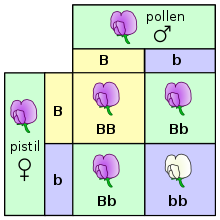A term used to identify a plant’s inherit characteristics and physical traits, including scent, taste, appearance, impact and efficacy. Phenotypes are the expression of genetics in the physical growing environment. Plants with the same genetics can display different phenotypes if they are grown under different conditions.
In genetics, the phenotype (from Ancient Greek φαίνω (phaínō) 'to appear, show, shine', and τύπος (túpos) 'mark, type') is the set of observable characteristics or traits of an organism. The term covers the organism's morphology or physical form and structure, its developmental processes, its biochemical and physiological properties, its behavior, and the products of behavior. An organism's phenotype results from two basic factors: the expression of an organism's genetic code, or its genotype, and the influence of environmental factors. Both factors may interact, further affecting phenotype. When two or more clearly different phenotypes exist in the same population of a species, the species is called polymorphic. A well-documented example of polymorphism is Labrador Retriever coloring; while the coat color depends on many genes, it is clearly seen in the environment as yellow, black, and brown. Richard Dawkins in 1978 and then again in his 1982 book The Extended Phenotype suggested that one can regard bird nests and other built structures such as caddis-fly larva cases and beaver dams as "extended phenotypes".


Wilhelm Johannsen proposed the genotype–phenotype distinction in 1911 to make clear the difference between an organism's hereditary material and what that hereditary material produces. The distinction resembles that proposed by August Weismann (1834–1914), who distinguished between germ plasm (heredity) and somatic cells (the body). More recently, in the Selfish Gene (1976), Richard Dawkins distinguished these concepts as replicators and vehicles.
The genotype–phenotype distinction should not be confused with Francis Crick's central dogma of molecular biology, a statement about the directionality of molecular sequential information flowing from DNA to protein, and not the reverse.
English
Etymology
pheno- + -type. (Date to be specified). From Ancient Greek φαίνω (phaínō, “to shine, to show, to appear”) and Ancient Greek τύπος
... Read More


